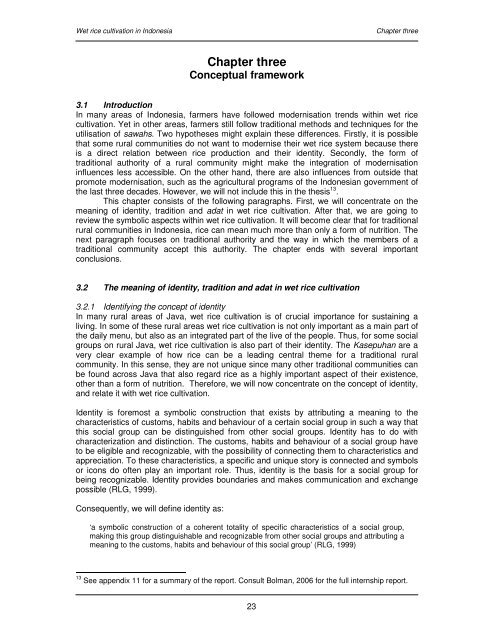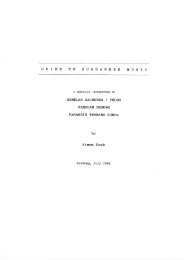Wet rice cultivation in Indonesia - Free EBooks Library
Wet rice cultivation in Indonesia - Free EBooks Library
Wet rice cultivation in Indonesia - Free EBooks Library
Create successful ePaper yourself
Turn your PDF publications into a flip-book with our unique Google optimized e-Paper software.
<strong>Wet</strong> <strong>rice</strong> <strong>cultivation</strong> <strong>in</strong> <strong>Indonesia</strong> Chapter three<br />
Chapter three<br />
Conceptual framework<br />
3.1 Introduction<br />
In many areas of <strong>Indonesia</strong>, farmers have followed modernisation trends with<strong>in</strong> wet <strong>rice</strong><br />
<strong>cultivation</strong>. Yet <strong>in</strong> other areas, farmers still follow traditional methods and techniques for the<br />
utilisation of sawahs. Two hypotheses might expla<strong>in</strong> these differences. Firstly, it is possible<br />
that some rural communities do not want to modernise their wet <strong>rice</strong> system because there<br />
is a direct relation between <strong>rice</strong> production and their identity. Secondly, the form of<br />
traditional authority of a rural community might make the <strong>in</strong>tegration of modernisation<br />
<strong>in</strong>fluences less accessible. On the other hand, there are also <strong>in</strong>fluences from outside that<br />
promote modernisation, such as the agricultural programs of the <strong>Indonesia</strong>n government of<br />
the last three decades. However, we will not <strong>in</strong>clude this <strong>in</strong> the thesis 13 .<br />
This chapter consists of the follow<strong>in</strong>g paragraphs. First, we will concentrate on the<br />
mean<strong>in</strong>g of identity, tradition and adat <strong>in</strong> wet <strong>rice</strong> <strong>cultivation</strong>. After that, we are go<strong>in</strong>g to<br />
review the symbolic aspects with<strong>in</strong> wet <strong>rice</strong> <strong>cultivation</strong>. It will become clear that for traditional<br />
rural communities <strong>in</strong> <strong>Indonesia</strong>, <strong>rice</strong> can mean much more than only a form of nutrition. The<br />
next paragraph focuses on traditional authority and the way <strong>in</strong> which the members of a<br />
traditional community accept this authority. The chapter ends with several important<br />
conclusions.<br />
3.2 The mean<strong>in</strong>g of identity, tradition and adat <strong>in</strong> wet <strong>rice</strong> <strong>cultivation</strong><br />
3.2.1 Identify<strong>in</strong>g the concept of identity<br />
In many rural areas of Java, wet <strong>rice</strong> <strong>cultivation</strong> is of crucial importance for susta<strong>in</strong><strong>in</strong>g a<br />
liv<strong>in</strong>g. In some of these rural areas wet <strong>rice</strong> <strong>cultivation</strong> is not only important as a ma<strong>in</strong> part of<br />
the daily menu, but also as an <strong>in</strong>tegrated part of the live of the people. Thus, for some social<br />
groups on rural Java, wet <strong>rice</strong> <strong>cultivation</strong> is also part of their identity. The Kasepuhan are a<br />
very clear example of how <strong>rice</strong> can be a lead<strong>in</strong>g central theme for a traditional rural<br />
community. In this sense, they are not unique s<strong>in</strong>ce many other traditional communities can<br />
be found across Java that also regard <strong>rice</strong> as a highly important aspect of their existence,<br />
other than a form of nutrition. Therefore, we will now concentrate on the concept of identity,<br />
and relate it with wet <strong>rice</strong> <strong>cultivation</strong>.<br />
Identity is foremost a symbolic construction that exists by attribut<strong>in</strong>g a mean<strong>in</strong>g to the<br />
characteristics of customs, habits and behaviour of a certa<strong>in</strong> social group <strong>in</strong> such a way that<br />
this social group can be dist<strong>in</strong>guished from other social groups. Identity has to do with<br />
characterization and dist<strong>in</strong>ction. The customs, habits and behaviour of a social group have<br />
to be eligible and recognizable, with the possibility of connect<strong>in</strong>g them to characteristics and<br />
appreciation. To these characteristics, a specific and unique story is connected and symbols<br />
or icons do often play an important role. Thus, identity is the basis for a social group for<br />
be<strong>in</strong>g recognizable. Identity provides boundaries and makes communication and exchange<br />
possible (RLG, 1999).<br />
Consequently, we will def<strong>in</strong>e identity as:<br />
‘a symbolic construction of a coherent totality of specific characteristics of a social group,<br />
mak<strong>in</strong>g this group dist<strong>in</strong>guishable and recognizable from other social groups and attribut<strong>in</strong>g a<br />
mean<strong>in</strong>g to the customs, habits and behaviour of this social group’ (RLG, 1999)<br />
13 See appendix 11 for a summary of the report. Consult Bolman, 2006 for the full <strong>in</strong>ternship report.<br />
23








